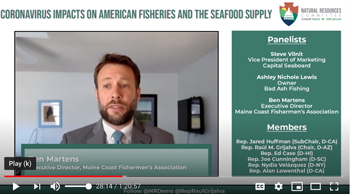Fishery Losses Due to Pandemic “Just the Beginning”
Continued from Homepage

Maine Coast Fishermen’s Association Executive Director Ben Martens was one of three speakers invited to testify before a U.S. House of Representatives subcommittee on the impacts of COVID-19 on the fisheries and seafood supply.
Screenshot courtesy of Water, Oceans, and Wildlife Subcommittee.
Also speaking were Steve Vilnit, vice president of marketing for Capital Seaboard in Jessup, Md.; and Ashley Nichole Lewis, owner and operator Bad Ash Fishing in Washington. Capital Seaboard is a wholesale food distribution business, providing fresh seafood and produce to food service operations, according to its website. Bad Ash Fishing, based in the state of Washington, offers guided fishing tours.
The speakers agreed that the pandemic has impacted seafood demand, not supply.
Despite growing interest in local seafood, Martens said, fishing communities are in jeopardy, because 70 to 80 percent of seafood is eaten in restaurants, which closed during the pandemic.
In Maine, he said, restaurants are the fishing industry’s most significant market.
“When the restaurants closed, buyers told fishermen not to fish,” he said. Prices fell 70 percent for most species and processors had to unload product at losses, he said.
“Without a definitive end to the pandemic, our losses are just beginning,” he said.
Martens said the industry is grateful to Congress for the $300 million in the CARES Act to assist fishermen and fishery-related businesses such as dealers, processors, and aquaculture operations affected by COVID-19. Of that, $20 million was designated for Maine, to be allocated by the National Oceanic and Atmospheric Administration; as of mid-May, the funds hadn’t been rolled out.
The Department of Marine Resources (DMR) issued a notice on May 13 explaining that, in order to qualify for funds from the $20 million, eligible individuals, businesses, or industry groups will have to demonstrate a revenue loss during a period in 2020 that is greater than 35 percent as compared to the prior five-year average over the same period.
“We are grateful to Maine’s Congressional delegation for their efforts to ensure these funds were appropriated,” the notice said. “However, this is one-time funding and will not be able to make up the majority of losses Maine’s seafood businesses will experience due to Covid-19.”
The DMR developed a brief survey, to be completed by May 22, to help the agency determine the priorities of Maine’s commercial fishing, seafood, aquaculture, and charter fishing industries, in order to develop Maine’s “spend plan.”
“What we’ve heard from
our dealers, buyers and
processors is that a lot
of those overseas market
are not available and
we don’t know when
they’ll come back.”
– Ben Martens
However, said Martens, the $20 million “won’t make a dent in the substantial losses along Maine’s working waterfront.”
Relatively speaking, Martens explained, Maine was lucky with regard to the timing of the start of the pandemic, which occurred during the off-season for most Maine fisheries.
“But the uncertainty of what lies ahead weighs heavily,” he said.
The crisis will have long-term economic impact on fishing families and businesses, he said.
Often, he said, fishermen operate within certain seasonal windows. For example, Maine’s three-month elver fishery opened a week late due to the pandemic, normal distribution channels were disrupted, and the per-pound price was a quarter of last year’s price.
The pandemic has disrupted the export market, he noted.
“What we’ve heard from our dealers, buyers and processors is that a lot of those overseas market are not available and we don’t know when they’ll come back,” he said.
In some cases, he said, the fishing industry will try to increase its domestic sales, but that’s hampered by restaurant closures, sporadic transportation, and the delicacy of many seafood products that can’t withstand long journeys.
Investment needed for the fishing industry to recover and, by extension, to protect seafood as an essential part of the nation’s food supply, includes stabilization of shoreside infrastructure and the working waterfront, he said. The current moment, he said, can be viewed as an opportunity to identify problems with the food system and develop solutions. It would also be useful to develop infrastructure that connects seafood providers with markets around the country, he said.
Vilnit said that, when restaurants closed in mid-March, demand for seafood provided through his company dropped 75 percent. That wasn’t much ameliorated when restaurants pivoted to takeout and delivery, because much seafood doesn’t travel well, he said.
Maryland has 5,500 fishermen, who are called “watermen” regionally. They can’t find enough market now to sell their products, Vilnit said.
“Every day we have fishermen call us, trying to get fish through our doors,” he said. “We can’t because we don’t have a place to sell it. We need the restaurants in order to continue moving this product.”
Normally, he said, the company processes thousands of pounds of product every day; that number is down to hundreds of pounds daily.
“This is an economic disaster because we can’t get the resource to the public,” Vilnit said.
Vilnit noted that seafood companies operate with “razor-thin margins.”
“There’s plenty of product out there,” he said. “But without restaurants, most of the product has no place to go.”
